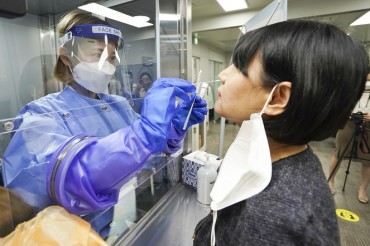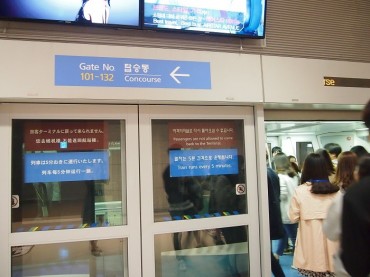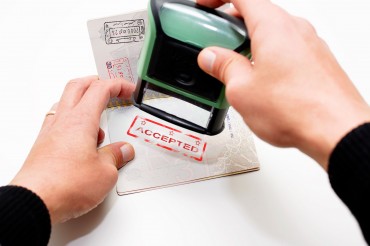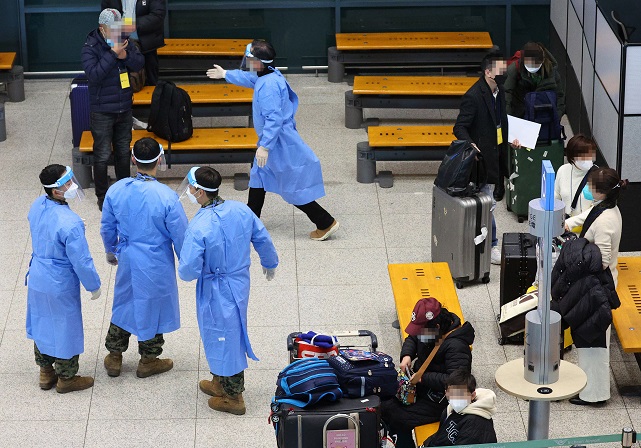
Quarantine officials guide travelers at Incheon International Airport’s Terminal 1, west of Seoul, on Jan. 3, 2023. (Yonhap)
SEOUL, Jan. 4 (Korea Bizwire) — South Korea’s new COVID-19 cases fell below 80,000 on Wednesday amid lingering concerns over a wintertime surge, and the government has taken steps to tighten entry rules to prevent the virus inflow from China and other regions.
The country confirmed 78,575 new coronavirus infections, including 172 from overseas, bringing the total to 29,299,166, the Korea Disease Control and Prevention Agency (KDCA) said.
It is slightly lower from the previous day’s 81,056 cases. The latest figure also marked about a 10 percent fall compared with a week earlier.
The country added 54 COVID-19 deaths, bringing the death toll to 32,355. The death rate stood at 0.11 percent.
The number of critically ill patients came to 623, up from the previous day’s 620. The figure has hovered over 600 since Sunday, a level seen for the first time in about eight months.
South Korea is stepping up efforts to stem the spread of the virus amid concerns over a wintertime surge and the inflow from China, which has experienced a virus resurgence amid eased curbs.
A PCR test within the first day of entry became a must for entrants from China from Monday.
Starting Thursday, arrivals from China should show either a negative PCR or antigen test for the coronavirus before boarding flights to South Korea.
They will be required to receive a PCR test within 48 hours before their arrival or an antigen test within 24 hours before their arrival.
Starting Saturday, travelers from Hong Kong and Macao will also be required to present a negative pre-entry virus test.
Of the 172 imported cases reported Wednesday, 131 were from China, and 19 were from other Asian nations, the KDCA said.
Over the past week, 587 COVID cases have been confirmed from overseas, and 41.9 percent of them were entrants from China.
The proportion for December jumped to around 17 percent from a mere 1.1 percent in November, according to the KDCA.
“The government has taken preemptive steps to prevent the virus inflow from overseas given the recent virus spread in China and the surge in COVID-19-related deaths in Hong Kong,” Health Minister Cho Kyoo-hong said, calling for thoroughly implementing antivirus curbs.
The government has said it will put in place additional measures regarding foreign entrants, if necessary.
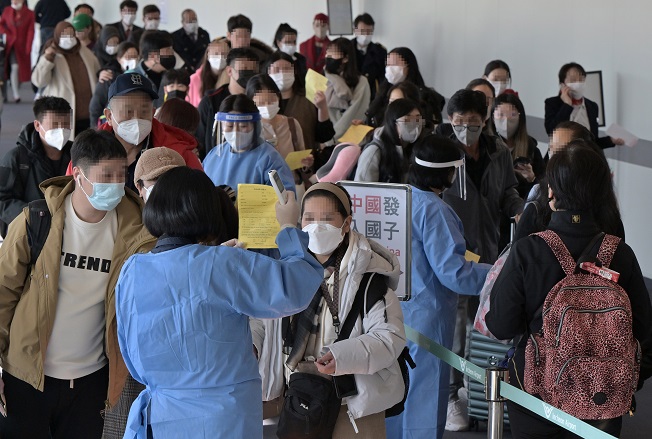
Quarantine officials introduce procedures for COVID-19 tests to entrants from China upon their arrival at Incheon International Airport, west of Seoul, on Jan. 2, 2023, when South Korea began to require a PCR test for all travelers from China as the virus rapidly spreads in the neighboring country. (Yonhap)
South Korea is also watching the developments regarding the new omicron subvariant of XBB 1.5, which has been spreading rapidly around the world recently. Experts said the subvariant could be more infectious and resistant to immune response.
The KDCA has said the country first found a XBB 1.5 case on Dec. 8, and a total of 13 cases have been detected so far, including seven from overseas.
Currently, the BA.5 variant is the dominant strain in South Korea.
As of Saturday, BA.5 accounted for 38.2 percent of the total infections here, down 7.9 percentage points from a week earlier.
Taken its subvariants into account, including BQ.1 and BF.7, the BA.5 variant accounted for 55.2 percent of the total cases detected in South Korea, according to the KDCA.
The proportion of the BN.1 variant rose to 33.3 percent from 24.4 percent a week earlier, it added.
The authorities put the nationwide risk level of the virus to “moderate” for the fourth week of December, which has been maintained for about the past two months.
(Yonhap)



